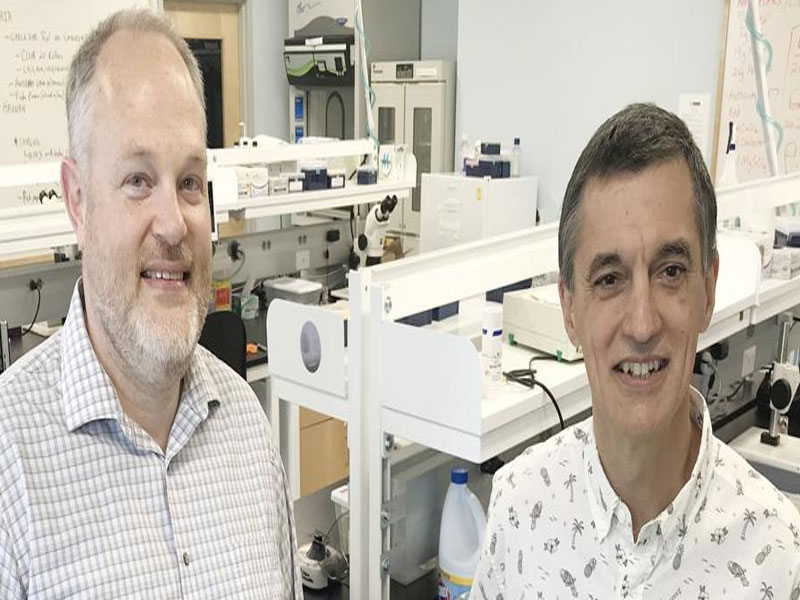UK becomes first to approve Casgevy genetic therapy for blood disorders
SOURCE: HTTPS://INTERESTINGENGINEERING.COM/
NOV 17, 2023
ECU Notes: Researcher learns new techniques to study mRNA
SOURCE: REFLECTOR.COM
SEP 11, 2021

An East Carolina University faculty scientist delved into the intricacies of messenger RNA this summer to learn more about how it gets sorted, stored and translated into proteins during gamete and embryo development to discover the causes of infertility and birth defects.
Brett Keiper, an associate professor and graduate director of biochemistry and molecular biology at the Brody School of Medicine at ECU, spent six weeks in July and August at Mount Desert Island Biological Laboratories in Bar Harbor, Maine. A three-year, $263,000 Mid-Career Advancement Award from the National Science Foundation is funding the work for himself and a doctoral student through 2024.
mRNA carries short bursts of genetic information from DNA in a cell nucleus to the main part of the cell — the cytoplasm — where proteins are made from its code. The cellular machinery then builds the proteins from the mRNA, as encoded by the DNA, that are right for that time and place in a cell to help it change to new types, as happens in an embryo. The translation factors also give the cell a way to control the rate of protein production — turning the mRNAs “on” or “off” as needed.
mRNA instructions are timed to self-destruct, like a disappearing text or Snapchat message. Once the instructions vanish, protein production stops until the protein factories receive a new message for a new fate.
At Mount Desert Island, Keiper worked with Dustin Updike, an associate professor and program coordinator of Maine INBRE (IDeA Network of Biomedical Research Excellence), a National Institutes of Health institutional development and student education and training program.
Specifically, Keiper learned to streamline the Crispr-Cas9 engineering process by adapting the Updike lab methodology. Crispr stands for clustered regularly interspaced short palindromic repeats. It can precisely target a designed edit in one gene out of the entire genome. Crispr is the premier gene-editing tool and is particularly versatile for animal model systems where such experiments are ethical and feasible.
He also learned more elaborate fluorescence microscopy techniques, RNA bioinformatics and genotype screening processes. “Most importantly, however, I am accomplishing some of the joint collaborative experiments that will be a foundation for future publications and hopefully another successful collaborative grant proposal with MDIBL,” he said.
Keiper and Updike met at scientific research conferences while still in training. “In the course of poster presentations, and more often over a beer (or, as Updike added, a Diet Coke) at the bar afterward, he and I and a group of our colleagues naturally gravitated to each other for lively discussions, arguments, and lots of laughs,” Keiper said. “It is the kind of environment that builds lasting comradery and solid friendships, not to mention good science.”
And if you think you’ve heard of mRNA, you’re right. The messenger molecule is the key ingredient in some newly developed COVID-19 vaccines.
Keiper said he and Updike have talked about ways to adapt their research process “to study RNA viruses like the coronavirus that causes the disease. While our research isn’t directed at the RNA vaccine technology, which I find brilliant, it may provide a simple animal model system to test therapies. It is a matter of understanding how the virus’ mRNA takes over a cell to begin with.”
In addition to his research at Mount Desert Island, Keiper helped train students in classical RNA-protein biochemistry approaches as part of Updike’s summer lab courses. Back at ECU, Keiper will pass along what he learned at Mount Desert Island to his own undergraduate and doctoral students. He hopes to arrange summer research opportunities in Bar Harbor for ECU graduate students.
“Right now, it is just an idea, but it is one I think would be a terrific educational opportunity and expand research collaborations,” Keiper said. “As a graduate director I plan to see if we might work out such an opportunity with the graduate school and with Brody.”
According to the NSF, mid-career scientists are at a critical career stage where they need to advance their research programs to ensure long-term productivity and creativity but are often constrained by service, teaching, or other activities that limit the amount of time devoted to research.
The Mid-Career Advancement Award program offers an opportunity for scientists and engineers at the associate professor rank or equivalent to substantively build and advance their research programs through partnerships, typically at an institution other than their home institution, according to the NSF. The goal is to enable and grow a more diverse scientific workforce at high academic ranks who remain engaged and active in cutting-edge research.
Keiper credited the medical school and his department chair, John Cavanagh, for supporting the grant and his travel to Maine.
School of Art and Design Alumni Exhibition on display
A showcase of artwork from 140 alumni of ECU will be on display at three Greenville venues through Sept. 25.
The host sites are the Wellington B. Gray Gallery in Jenkins Fine Arts Center and the Janice Hardison Faulkner Gallery in Joyner Library, both on the campus of ECU, as well as Emerge Gallery in Uptown Greenville.
ECU graduates from the classes of 1969 through 2021 who live across the United States, including 18 local artists, are participating in the exhibition.
Featured local artists include Kelly Adams, Winterville; Dan Black, Greenville; Ashley Cagle, Greenville; Brian Culbertson, Greenville; Scott Eagle, Greenville; Charlotte Fitz-Daniels, Winterville; Holly Garriott, Greenville; Tom Grubb, Washington; Nelle Hayes, Greenville; Jacquelyn Herling, Winterville; Jane Lawrence, Greenville; Sarah Lazure, Greenville; Sue Luddeke, Greenville; Elizabeth Markowski, Greenville; Andy McLawhorn, Winterville; Maria Modlin, Winterville; Vicky Smith, Snow Hill; and Alicia Zieg, Greenville.
Painting and drawing, video, graphic design, textiles, metal design, ceramics, printmaking, sculpture, wood design, photography, industrial design, book arts and mixed media are included.
“After being delayed by a year due to the pandemic, I’m thrilled that we are finally hosting this wonderful exhibition of artwork from our talented alumni,” said Kate Bukoski, director of the School of Art and Design. “The work in the exhibition showcases a variety of media from graduates ranging from our first MFA class to just this past year. There is something for every viewer in this extensive exhibition!”
LATEST NEWS
Augmented Reality
Hi-tech smart glasses connecting rural and remote aged care residents to clinicians
NOV 20, 2023
WHAT'S TRENDING


Data Science
5 Imaginative Data Science Projects That Can Make Your Portfolio Stand Out
OCT 05, 2022

SOURCE: HTTPS://INTERESTINGENGINEERING.COM/
NOV 17, 2023
SOURCE: HTTPS://GENETICLITERACYPROJECT.ORG/
SEP 05, 2023
SOURCE: HTTPS://WWW.SCIENCEDAILY.COM/
AUG 07, 2023
SOURCE: HTTPS://WWW.SCIENCEDAILY.COM/
JUL 24, 2023
SOURCE: HTTPS://NEWS.MIT.EDU
JUL 20, 2023
SOURCE: BIOSPACE.COM
OCT 27, 2022